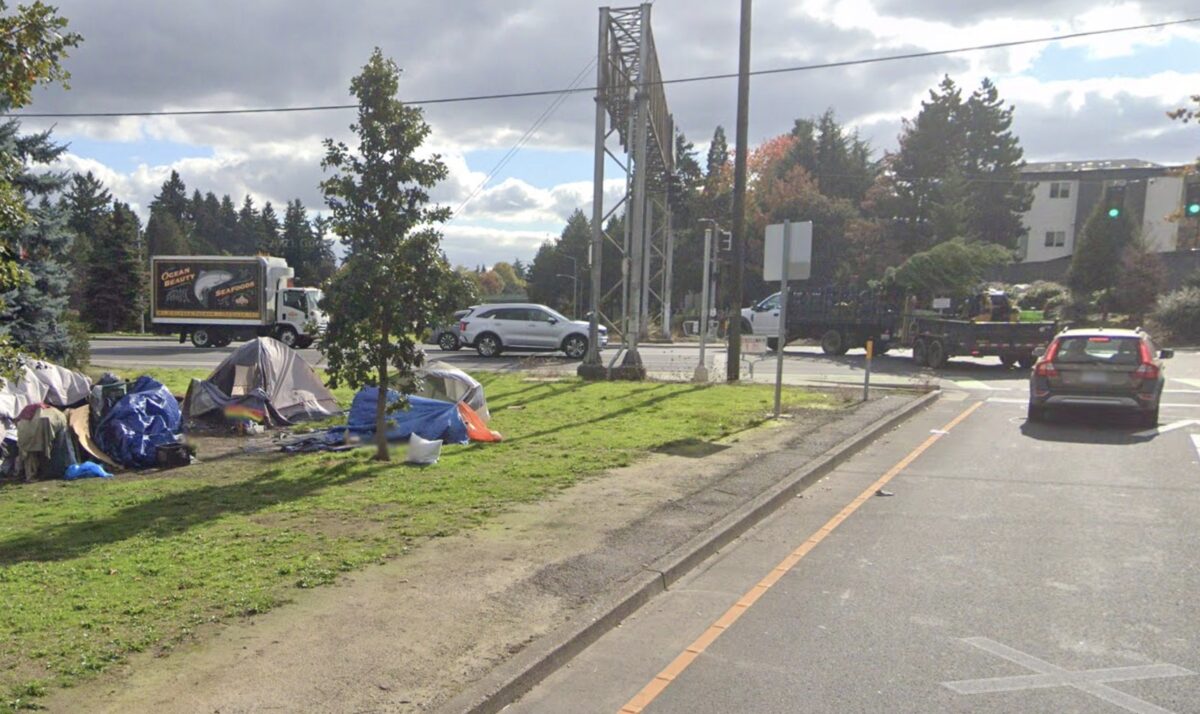
“Cities have shown they have the capacity and resources to quickly adapt to new crises. These adaptations need to prioritize vulnerable communities and underserved areas.”
According to a report by the City of Portland released last year, 19 out of the 27 people killed in a traffic crash while walking on Portland’s streets last year were experiencing homelessness. This is 70% of the total number of pedestrians killed, and about a third of the total people killed in car crashes of any kind.
The staggering statistic sent shock waves through Portland. Mayor Ted Wheeler’s solution was to declare a state of emergency and ban camping at so-called ‘Inherently Dangerous Camping Locations,’ which include streets on PBOT’s High Crash Network and along state and federal highways.
But homeless and transportation advocates said the move could cause additional trauma by uprooting people and further criminalizing homelessness while not doing anything to solve the root of the problem.
That’s where a team of six students who call themselves Street Perspective at Portland State University’s Master of Urban and Regional Planning (MURP) program stepped in with a planning and research project titled, Safety Interventions for Houseless Pedestrians. Angie Martinez, Meisha Whyte, Asif Haque, Nick Meusch, Peter Domine, and Sean Doyle presented their findings at last week’s Friday Transportation Seminar hosted by PSU’s Transportation Research and Education Center.
This study focused mainly on the transportation policy lens, but also looked at potential housing and shelter solutions.

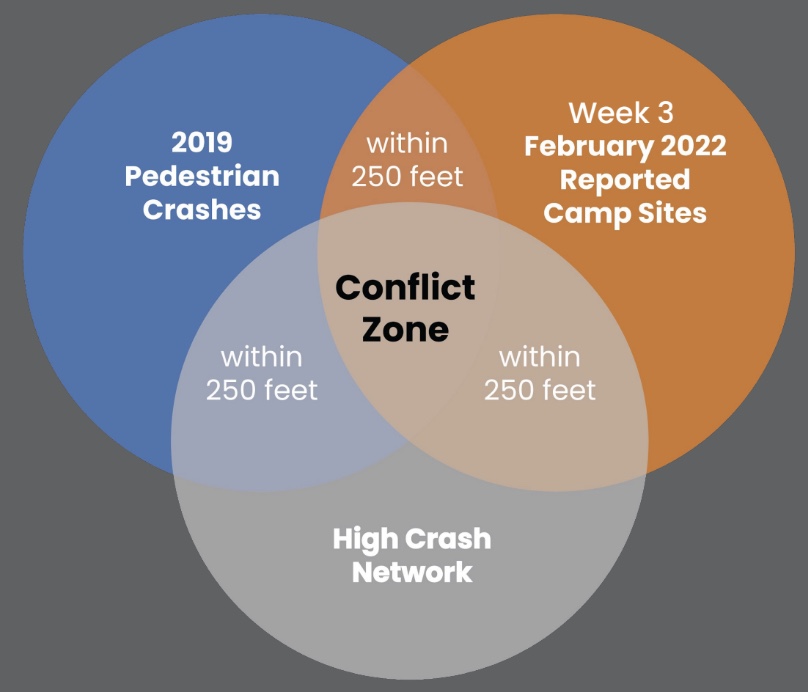
There are many potential reasons why homeless people are at increased risk of being killed on the streets, but a main factor is they choose to set up campsites near highway ramps and along arterials. The large, vegetated buffer zones around freeways are perfect for pitching tents and arterial streets are often near services, stores, and other destinations. Unfortunately they’re often near many high-speed drivers.
The Street Perspective team talked to people living on the street and service providers who work on the ground. They mapped out conditions after making site visits. They crunched data on collisions.
One of their main takeaways was how harmful sweeps in these environments can be. Presenters pointed out how forcing people to relocate to areas where car traffic is calmer may mean cutting them off from services they rely on and communities they’ve built.
“Many of the negative effects that come from harassment and sweeping are due to this loss of community that provides people with some sense of stability and connection,” Sean Doyle, one of the Street Perspective students, said during the presentation.
So, what tactics do the Street Perspective students indicate could work to help keep people experiencing homelessness safe from traffic violence? Here’s a recap of their ‘promising practices.’
Safe Streets for All
At the beginning of the pandemic, PBOT enacted the Safe Streets Initiative and installed traffic calming measures on certain streets to give people more room to walk, bike and roll while social distancing and staying safe from car traffic. The Street Perspective team suggests PBOT tackle the traffic violence unhoused people face by applying similar measures to areas near essential resources where campsites are set up.
“Cities have shown they have the capacity and resources to quickly adapt to new crises. These adaptations need to prioritize vulnerable communities and underserved areas,” the presentation said.

Infrastructure
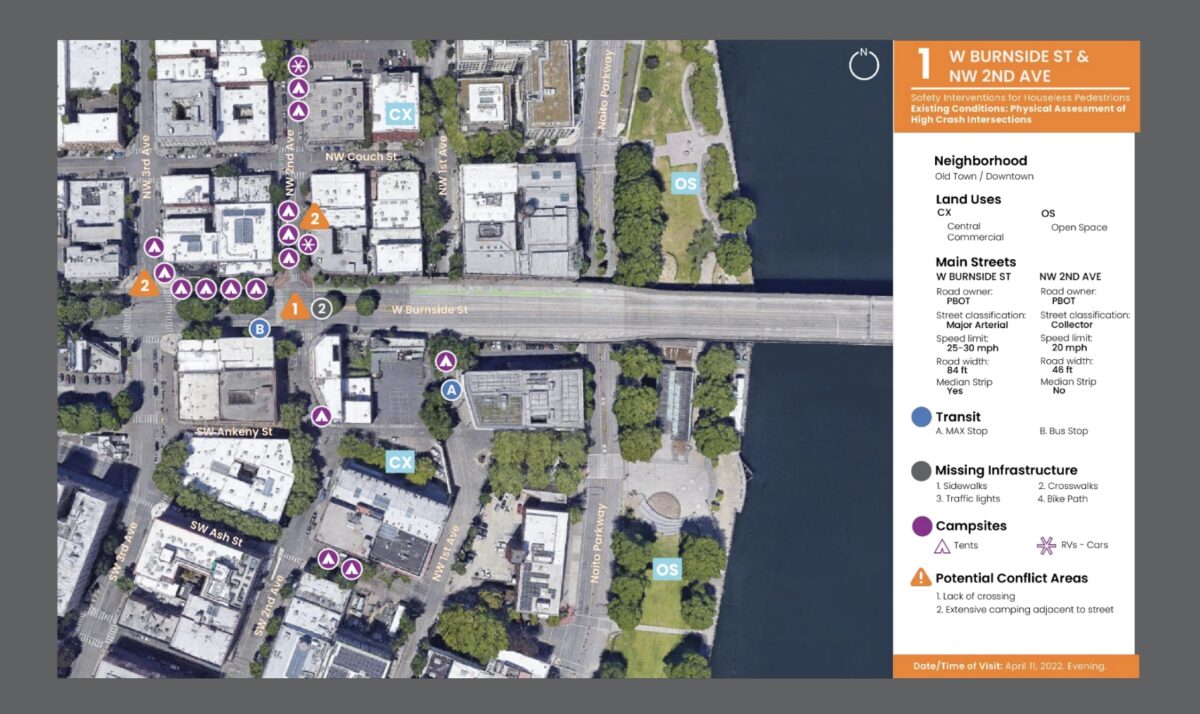


Active transportation investments would not necessarily need to specifically target homeless people — as anyone who walks or bikes in an area would benefit from safer infrastructure — but these investments could be prioritized in places where homeless people are disproportionately impacted.
The Street Perspective study looked at three intersections in Portland (above) located in proximity to homeless campsites where pedestrian injuries have occured (all three are on the PBOT High Crash Network): W Burnside St and NW 2nd Ave; NE Sandy St, NE Halsey St, and NE Cesar Chavez Blvd; and NE Glisan St and NE 122nd Ave.
While the specifics vary, the study reported that they all have inadequate crossings, missing sidewalks and cater to people driving cars at the detriment of everyone else.
The types of improvements the Street Perspective team suggests be made to these dangerous intersections are the same treatments PBOT has done at other intersections around the city, such as enhanced street lighting, improved crosswalk visibility and speed reduction measures. The students suggest a more broad implementation would provide one long-term solution to the unsafe conditions homeless people face on our streets that is more effective than simply moving people away from the dangerous intersection without doing anything to fix the problem.
Better and More Shelters
While the Street Perspective students say sweeping campsites is not a helpful long or short-term solution to the crises our unhoused neighbors face, that does not mean it is ideal to have people living next to high crash corridors. But homeless people are not a monolith, and will have different wants and needs for their future housing. There are potential steps the city could take to prevent fatalities while giving people a choice about where they want to live. This could include: providing places for car and RV camping, which provide more security compared to being unsheltered on the street (and which PBOT Commissioner Jo Ann Hardesty has already made progress on); sanctioned campsites in safer locations; or tiny home villages and motel vouchers.
The students provide a more extensive list of proposed solutions in the full presentation which is available via YouTube. They also acknowledge the limitations of their work because it mainly focuses on transportation infrastructure. In order to see real changes, this crisis will need to be tackled holistically.
“There is no single solution. Infrastructure alone cannot reduce speeds,” one presenter said. “Traffic safety is intertwined with shelter and necessities.”
Correction: We initially referred to the MURP students as ‘researchers,’ when some of the work the Street Perspective team should instead be characterized as ‘planning.’ We have changed the language appropriately.
We also reported that pedestrian fatalities had occurred at the sites the students chose to study. This was an error – these sites were chosen based on crashes occurring within 250 feet of a campsite resulting in pedestrian injury, not necessarily fatality. We regret any confusion this may have caused.



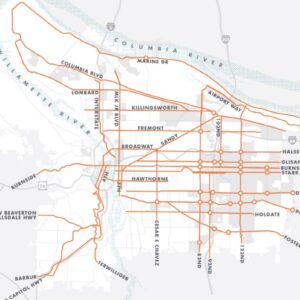

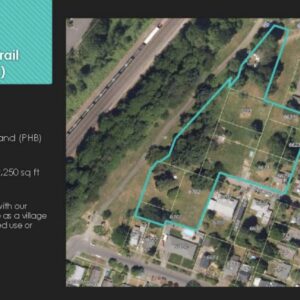
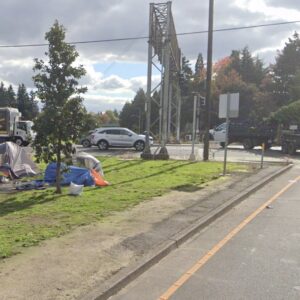
Thanks for reading.
BikePortland has served this community with independent community journalism since 2005. We rely on subscriptions from readers like you to survive. Your financial support is vital in keeping this valuable resource alive and well.
Please subscribe today to strengthen and expand our work.
We’re providing funding for affordable housing, drug treatment, and mental health services. What more can we do to address the root of the problem? Supplying tents and letting folks camp along highways is not much of a solution, and is not how I voted to “address the problem.”
“This one simple trick will stop homeless people camping near roads from getting run over!”
Read the plan when it’s released? The problem addressed is to keep people alive not solve homelessness.
I was responding to the comment about “solving the root of the problem”, which is getting people off the street, not the Band-Aid of make it safer to sleep there.
Both the NE Halsey and W Burnside diagrams up above note “Lack of crossing” as a contributing factor, when in both cases, a marked, signalized crossing is within spitting distance of both incidents.
It looks like ODOT has solved the Halsey camp issue. After multiple destructive fires and a fatality, the camp has been replaced with boulders.
Here’s a thought. How about not allowing homeless drug addicts to establish illegal drug camps on public land?
It’s pretty sad with the lack of action by the City & County students feel compelled to do this study.
Is offering someone a temporary roof (and modicum of safety) over their head and a meal that difficult of a reach for the politicians with tons of taxpayer money at their disposal?
From what little has been done is an embarrassment.
Most don’t want that roof if it means having to give up their drugs.
Of course.
There is no single solution that will help folks. My suggestion is just one of many and not all encompassing.
However, if there were enough temp housing made available for all those on the street whether they use it or not, the City can at least quit allowing camping everywhere and enforce the anti-camping laws. Of course the city politicians will have to get a spine before that’ll ever happen.
Agreed. I think that was the gist of Sam Adams’ draft plan that the homeless industrial complex and their representatives in city and county government got so apoplectic about.
The folks at the city don’t want to enforce anti-camping laws. Even if there as enough shelter available, we’d hear some new nonsense about why these out-of-towners need to be able to come here and do whatever they want at the expense of the other 99.9% of people who live here.
Seriously?, Hardesty (or any of the other commissioners or mayor) hasn’t done anything of substance to help the houseless, lots of promises but no real action. Vote her out in Nov.!!
In some locations, the presence of people camping may make a street a residence district, requiring slower speeds and the same “safe” conditions to which people who live in permanent homes are entitled.
What constitutes a “residence district”, and what “safe conditions” are required there? We have single family houses on almost all major arterials, which, as far as I know (and that’s pretty far), requires no special street treatment.
So you’re saying that instead of using speed bumps and diverters to slow traffic, we use human beings?
We’re through the looking glass, folks.
Go ahead and post 20mph signs. They will all be ignored.
The operation was a success as the autopsy will show.
The Portland State University programs are deeply woven into a part of the homeless industrial complex. Colleges are business as well. Wheeler created a new rule. Like usual, new rules that won’t be enforced, ever; unless it is a ruse for removing homeless that form near rich people’s homes.
If all these rules are actually enforced, their School of Social Work have minimal employment prospects.
That was my takeaway – not a single mention of enforcement. Just more workarounds because we don’t want to offend anyone.
Much like the BikePortland comment section, PSU appears to be an echo chamber.
The PSU echo chamber is nothing new Chris. PSU actually has a School of Engineering and I know several tenured engineering professors who are frustrated at how only the woke progressive type of research is supported or promoted by PSU. Real engineering research on buildings or transportation infrastructure withstanding earthquakes is only conducted and supported by OSU in Corvallis because it’s doesn’t fit the PSU narrative or demographic for woke “academic” research.
Can you give us an example of “woke” engineering research? Actual engineering research, not a MURP graduate student project.
My takeaway is that the group wants Portland to implement bespoke infrastructure improvements catering to specific camps near dangerous areas. Tell me how that would result in anything other than the camps becoming more attractive to use, therefore more populated and an even more severe safety issue.
Never mind that camps and derelict vehicles block sidewalks, bike lanes and sightlines, forcing pedestrians to walk in the street and creating a hazard for all road users regardless of housing status. Hmm, maybe that had something to do with all the pedestrian injuries near these sites?
As usual, PSU’s goal seems to be perfecting the mental gymnastics required to make a massive and rapidly growing humanitarian crisis into a permanent fixture of life in Portland. How this could be seen as anything except an attempt to further legitimize and normalize camping along high-crash corridors is beyond comprehension. And people wonder how we got where we are today?
I see a problem with how this article is presented. First, the author cites the city’s pedestrian fatality stats:
However, the study isn’t investigating these fatalities, specifically, rather:
Were the injured persons homeless? Or were they housed people forced to walk or bicycle, scoot, etc. in the street because sidewalks or bike lanes were blocked by tents, vehicles or associated refuse?
Our city’s tolerance for the continued seizure and abuse of public property has put my life at risk. How about yours?
Drugs are the root of the problem. That’s not to say all people on drugs are bad or stupid people. Many who are addicted to opioids started with prescribed oxycontin, etc. Dating back to the late 90s certain doctors overprescribed such drugs, causing countless thousands to become addicts. Then there’s also people who tried what they thought were more mild drugs but have increasingly become laced with more hardcore drugs. Or, yes, sometimes people were in a bad place in life and made a stupid decision to try hardcore drugs, quickly making them long-term addicts. To further compound the problem, drugs like heroin are now dirt cheap.
I read an article that discussed the numerous American soldiers (and soldiers of other countries) who became addicted to heroin overseas during the Vietnam War. The one thing that worked to break the addiction was to relocate large groups thousands of miles where they had no access to those drugs. Often they worked on farms. They must have suffered excruciating withdrawal in the short term, but not long after, the soldiers had their lives back. Sometimes tough love is the only viable solution.
That diagnosis and prescription will be immediately be rejected by the homeless industrial complex and its supporters. It makes too much sense and would threaten their claim to the moral high ground and their funding.
I must have missed something. I thought to support an industrial complex someone needs to be making gobs of money. As far as I can tell the homeless situation just costs many parts of society lots of money. So who’s on the in making all this money?
Heads of non-profits and the owners of construction companies.